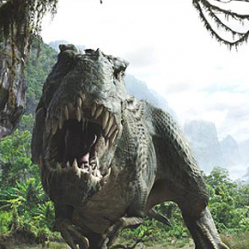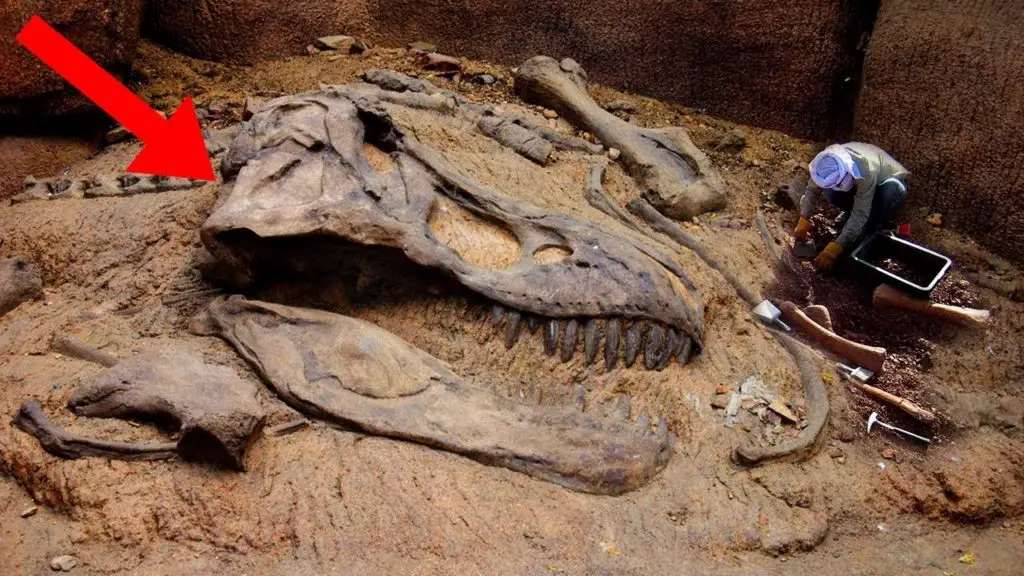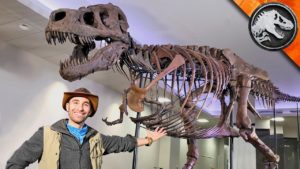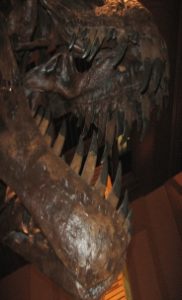No other dinosaur has achieved the renown of the fearsome Tyrannosaurus Rex- Greek for “tyrant lizard king.” Extinct for 65 million years, T. Rex has nonetheless been immortalized, in film, fiction, and popular imagination. Arguably the largest land carnivore ever, T. Rex roamed a semi-tropical landscape of what is now Asia and western North America during the Late Cretaceous Period. Contemporaries included the horned herbivore Triceratops, the armored, club-tailed ankylosaurus, and fellow predator velociraptor, who was in reality about one-third the size depicted in the Jurassic Park movies.
 The first T. Rex fossils were discovered in Montana in 1900. In 1990, a nearly complete set of bones was unearthed on an Indian reservation in South Dakota. The assembled T. Rex skeleton –nicknamed “Sue” after its discoverer- is on display at the Field Museum in Chicago, Illinois. Other archaeological finds include fossilized T. Rex skin showing that this dinosaur had a rough, scaly hide like an alligator’s, and fossilized dung, revealing pieces of Triceratops bones (EnchantedLearning).
The first T. Rex fossils were discovered in Montana in 1900. In 1990, a nearly complete set of bones was unearthed on an Indian reservation in South Dakota. The assembled T. Rex skeleton –nicknamed “Sue” after its discoverer- is on display at the Field Museum in Chicago, Illinois. Other archaeological finds include fossilized T. Rex skin showing that this dinosaur had a rough, scaly hide like an alligator’s, and fossilized dung, revealing pieces of Triceratops bones (EnchantedLearning).
As theories about dinosaurs have evolved, so too have theories about the tyrant lizard king. Originally scientists thought that T. Rex carried itself upright, but now believe that the animal adopted a more literal stance. In addition, fairly recent archaeological finds cast doubt on T. Rex’s status as the largest land carnivore. Some studies suggest that T. Rex was fleet of foot, attaining speeds of 15 to 20 miles per hour, another claim the opposite was the case. But the biggest debate centers on whether Tyrannosaurus was really a predator, or simply a scavenger. While most predators will gladly steal another hunter’s meal if the opportunity presents itself, paleontologist Jack Horner believes that fossil evidence shows T. Rex to have been a lumbering, clumsy brute, poorly-equipped for chasing down prey, which it could not even have seen very well given the small size of its occipital lobes. And its ridiculously tiny forearms would have been useless in a fight. Conversely, the ample olfactory chambers would have enabled T. Rex to smell carrion at long distances, and T. Rex was big and ugly enough to scare smaller carnivores away from their kills. To many dinosaur buffs, this is understandable quite a blow to T. Rex’s prestige, but they can take some comfort in the fact that the truth may be irretrievably buried with the secrets of eons past (Locke).
T-Rex Fun Facts
Table of Contents
The Tyrannosaurus or T. Rex existed in the late Cretaceous period some 65 million years ago. A carnivorous dinosaur and an extremely popular icon in today’s movie culture this dinosaur is probably one of the most talked and read about dinosaurs ever to have existed. With some amazing scenes in both Jurassic Park and the recent King Kong movie it’s no wonder he’s so popular.
The name Tyrannosaurus Rex means ‘Tyrant Lizard King’ which stems from the Greek word ‘tyranno’ meaning tyrant, ‘saurus’ meaning lizard and ‘rex’ meaning king. The grand name comes directly from the fact that the T. Rex was most probably one of the largest and most terrifying carnivores of its time.
Taxonomy
The Tyrannosaurus a bipedal theropod was a part of the Tyrannosaurid family which existed in most parts of western North America as well as some parts of Asia. For a long time, it was believed that the T. Rex was the largest carnivorous dinosaur of them all, but that was before the Giganotosaurus and Carcharodontosaurus were discovered.
Despite not being the largest of the carnivores it was still the largest member of the Tyrannosaurid family and of course, recognized as one of the fiercest land predators ever to exist. Over time scientists have classified and re-classified discoveries in and out of this group as quite clearly the tyrannosaurid group is a benchmark in its own right.
As an example in 1955 Russian paleontologist, Evgeny Maleev named a new species called Tyrannosaurus bataar which was discovered in Mongolia. By 1965 this species had been regrouped and renamed to Tarbosaurus bataar. Despite the renaming, it’s still thought of being a close sister and Asian version of the Tyrannosaurus rex.
Physical Appearance
At over 20 ft tall, 40 ft long, and weighing up to 8 tonnes the Tyrannosaurus was longer than the width of a tennis court, heavier than an African bull elephant, and tall enough to look into an upstairs window. Its massive legs bore its weight on three large, bird-like clawed toes, whilst its arms which despite being extremely short were strong and powerful with 2 clawed digits.
Large Skull
One feature that stood out in all Tyrannosaurids was the size of their skull. In simple words it was huge and at 5ft long, the skull was almost half as long as the backbone between the hips and the head. The head was basically the size of a small car and considered huge even for dinosaurs.

To support such a large head the T. Rex had an extremely short but muscular neck giving it extra strength and allowing it to stabilize the head as it moved. Obviously, a huge skull meant plenty of room for large teeth that were so hard that they were known to penetrate even bone.
All these characteristics meant that the Tyrannosaurus Rex had one of the strongest bite forces of any dinosaur that ever existed. The pressure exerted in a single bite was equivalent to around 4 tonnes per square inch. Obviously, with such mean bite teeth are bound to be lost which luckily for the T. Rex and the rest of the tyrannosaurid family grew back throughout its life.
Vision & Smell
The T. Rex had a small brain in proportion to its body, but even so, it was larger than most other dinosaurs. Its eyes were positioned on the front of the skull which is very similar to the way human eyes are positioned and would have meant its ability to focus and judge distant objects was very good.
 Scientists also believe that a large portion of the brain was allocated to smelling making the T. Rex a very strong sniffer. If you combine the strength of the eyes with the strong sense of smell you very quickly appreciate how these two natural abilities would have made the Tyrannosaurus a very effective predator.
Scientists also believe that a large portion of the brain was allocated to smelling making the T. Rex a very strong sniffer. If you combine the strength of the eyes with the strong sense of smell you very quickly appreciate how these two natural abilities would have made the Tyrannosaurus a very effective predator.
The Tail
As well as a large head the Tyrannosaurus also possessed an equally large and stiff tail. Most scientists believed the weight of the tail would have meant it dragged on the floor as it moved, however more recent studies challenged this stating that the tail’s weight formed a counterbalance to the extremely heavy head. If this were the case then it would actually be carried in the air to counter the heavy head which would have been in a forward-leaning position.
Tiny Arms
Despite having arms that were only 2-3 ft long they were still however extremely muscular and able to support hundreds of pounds of weight.
So what were these arms used for? Well, a number of theories are plausible and one of them is that the arms were used to assist the T. Rex whilst lifting itself off the floor. Others say that the two sharp claws on each arm were used to hold its prey whilst it devoured them with its mouth.
A Quick Size Comparison
When we start to talk about the Tyrannosaurus and its huge head it’s very easy to forget what its overall size was in comparison to the long-necked sauropod herbivores. Some examples include the Sauroposeidon which is the tallest known dinosaur and stood at 55 ft (17 meters) in height, the T-Rex as you can see was almost a third of its height.
In fact, there were even larger sauropods such as the Argentinasaurus who was 115 ft long (35 meters) and weighing between 80-100 tonnes. Compare that to the T. Rex which was only 6-8 tonnes and 40 ft in length and you quickly realize the size difference. We throw this section in because most readers get so amazed with the grandness and power of the T. Rex that they often forget his overall size in comparison with the rest of the dinosaurs.
T-Rex Top Speed
The Tyrannosaurus Rex had one of the strongest not to mention the longest legs of any Theropod. These massive legs combined with three huge toes on each foot meant the T. Rex was able to take very long strides covering distances of up to 15 ft with each step, thus giving it a top speed of around 25 mph.
Behavioral Patterns & Hunting
It’s thought that the T. Rex probably lived close to its prey which was in most cases plant-eating herbivores. This would imply that its primary dwelling would have been near forests, open woodland, rivers, and valleys rich in plant life.
We know the T. Rex was probably well suited to hunting but how it hunted is an issue up for debate. Most scientists feel that due to the lack of fossil evidence suggesting group hunting, it was most likely a solitary hunter.
How it fared against other dinosaurs who did hunt and exist in packs is an interesting question. Some have said the T. Rex possessed such a powerful bite that this alone would have been a huge deterrent and factor in maintaining its superiority over other large dinosaurs and pack hunters.
It’s absolutely certain that the Tyrannosaurus would have eaten large dinosaurs if they were already dead but may also have attacked animals that were either too young, sick or old to protect themselves. Some scientists believe this behavior is scavenger like whilst others feel it’s just a fact of life.
T. Rex Prey
In terms of what and who it preyed upon, there’s fossil evidence to suggest it commonly consumed both Triceratops and the duck-billed Hadrosaurs such as the Corythosaurus. In most cases, scientists feel that an initial power bite would have severely crippled its prey causing massive blood loss. This would eventually cause its prey to lose strength and even collapse. At this point, the T. Rex could quickly use both its foot claws and mouth to finish off its opponent.
Fossils
In total around 30 Tyrannosaurus Rex fossils have been recovered with the first T. Rex fossil being discovered in 1902 by Barnum Brown in South Eastern Montana, USA. Most other T-Rex fossils were also found in this region but some have also been found in Canada and parts of Asia such as Mongolia.
———
 The Tyrannosaurus is one of the largest and most well known of all the species of dinosaurs. This is because of its massive size and powerful teeth and jaws. It is nicknamed the “King of The Dinosaurs,” and is second in size and strength only to the recently discovered Spinosaurus.
The Tyrannosaurus is one of the largest and most well known of all the species of dinosaurs. This is because of its massive size and powerful teeth and jaws. It is nicknamed the “King of The Dinosaurs,” and is second in size and strength only to the recently discovered Spinosaurus.
Tyrannosaurus was a vicious theropod that lived during the late Cretaceous period. As of 2005, about 30 of these creatures have been found, and a few skulls have been found completely intact. Despite the reports and findings of much larger predators such as Spinosaurus, Tyrannosaurus has become a cultural icon, millions of years after it became extinct.
All of the discoveries of Tyrannosaurus fossils have been made in North America. At this time, it seems North America is the area of the world where it lived. The first fossil was found in 1892, and by 1912 it had been given the name Tyrannosaurus Rex by Henry Osborn. The second Tyrannosaurus fossil was found in Wyoming in 1900.
The Tyrannosaurus was a large and terrifying creature. It was about 30 to 40 feet in length, stood up to 16 feet tall, and weighed approximately 4 to 8 thousand pounds. This would have made the Tyrannosaurus one of the largest land predators ever seen in history. Even for a theropod, its bones are very large, and its teeth were shaped like ovals rather than blades. If the teeth of the Tyrannosaurus were damaged after heavy use, they would grow back, unlike mammals.
The Tyrannosaurus had a fairly large brain compared to other dinosaurs, but was not seen as being very intelligent compared to most mammals. The neck was short and strong so that it could support the massive skull. By comparison, its arms were very short, and most paleontologists believe they were used for holding prey while the Tyrannosaurus used its head and teeth to crush the neck of the victim. It was also probably used during mating and to give the dinosaur balance.
There is also a possibility that Tyrannosaurus had feathers, like many theropods. Smaller versions of the Tyrannosaurus have been found with feathers, especially in Mongolia. However, most believe the larger T.rex had scales, like many dinosaurs. There is also some debate about whether the T.rex was a scavenger or a hunter. While some paleontologists believe it was only a scavenger, most believe it was both, eating whatever it could find or hunting its prey.
How many specimens of Tyrannosaurus Rex have been found?
The bones of about 30 Tyrannosaurus Rex individuals have been found so far, more than half of which have been found since 1990. The most complete T. rex specimen, which is more than 90% complete, is known as “Sue” and was discovered by Sue Hendrickson in South Dakota in 1990. “Sue” is on permanent display at the Field Museum of Natural History in Chicago.
How big was T. rex?
T. rex grew to be more than 40 feet in length and is estimated to have weighed from 5 to 7 tons, or more. The T. rex, “Sue”, which is the largest T. rex known from nearly complete material, is 41 feet long. Other partial T. rex remains suggest that some individuals may have been larger, however.
When and where did T. rex live?
T. rex lived at the very end of the Cretaceous period, from 67 to 65 million years ago, in the western United States and western Canada. T. rex fossils have been found in Montana, New Mexico, North Dakota, South Dakota, Colorado, Wyoming, Alberta, and Saskatchewan.
Was T. rex the biggest dinosaur?
No. The largest dinosaurs were the sauropods. The largest dinosaur known is the sauropod Argentinosaurus, which is estimated to have been 120-150 feet long and weighed up to 100 tons. This would make Argentinosaurus more than 3 times longer than T. rex and more than 10 times as heavy. Until recently, T. rex was the largest known meat-eating dinosaur, but scientists have recently found other types of meat-eating dinosaurs that may have been larger than T. rex, such as Giganotosaurus and Carcharodontosaurus.
How big are T. rex’s jaws?
T. rex’s jaws were up to 4 feet long and had 50 to 60 large teeth that were strong enough to crush bone. The size of teeth varied in an adult T. rex, and if it lost a tooth, a new one grew in to replace it. It is estimated that T. rex’s jaws could take up to several hundred pounds of meat in a single bite.
What did T. rex eat?
T. rex was a meat eater and was at the top of the food chain during the late Cretaceous. Evidence that T. rex ate meat, apart from the shape of its jaws and teeth, include some fossilized bones of other types of dinosaurs with T. rex tooth marks in the bone and a recently discovered fossilized T. rex coprolite (fossilized poop) which contained crushed bones of an unlucky herbivorous dinosaur.
How well could T. rex see?
T. rex probably had extremely good vision. Fossils of T. rex skulls show that it had large visual lobes in its brain that processed visual information. Scientists think that T. rex probably also had depth perception (since both eyes faced forwards on the front of its skull).
How well could T. rex smell?
T. rex had an extremely good sense of smell. Fossils of T. rex skulls show that it had very large olfactory lobes in its brain that processed information about smells. It probably relied on its sense of smell to locate food and water, and perhaps to locate a mate.
What color was T. rex?
No one knows for sure. Although fossils of various types of dinosaur skin have been found which show the texture of the skin, the color of the skin is not preserved during the fossilization process. Dinosaurs were almost certainly, however, not limited to the dull grey and green colors depicted in paintings from the 1940s and 1950s. Today, many extraordinary dinosaur artists draw inspiration from living animals and paint their dinosaurs in a variety of colors, including tiger-like stripes for camouflage and brightly colored heads for mating and display.
How fast could T. rex run?
No one knows for sure. Fossilized footprints show that some medium-sized theropods were able to run between 25-30 miles per hour. Some paleontologists believe that T. rex was a fast runner and may have been capable of speeds up to 40 miles per hour, while others think it was much slower. A footprint that has been attributed to T. rex suggests that the individual that made the print was moving at least 9-10 miles per hour, which is about the speed of a good marathon runner.
How did T. rex use its arms?
T. rex’s arms were about the same size as our own arms, about 3 feet long. Although T. rex’s arms were small relative to its size (they were not able to even reach its mouth) -they were extraordinarily strong. Studies have shown that each T. rex arm was able to lift up to 400 pounds. No one is sure how T. rex used its arms, but the strength and limited range of motion of the arms suggest that they were probably used as a set of grappling hooks–to latch onto something, such as another animal or a large chunk of meat, and pull it towards its chest. This would have been useful during a battle, during mating and perhaps for carrying large chunks of meat away from a kill site. How to do that, however T. rex seems to have come in two sizes; large and extra-large. Some scientists speculate that the “extra-large” T. rexes (called the “robust” type) were the females, in part because females are larger than males in many types of animals. Also, the smaller types of T. rex (called the “gracile” type) have a bone which the bigger ones don’t have and which is present only in males of some living animals related to dinosaurs. Many more specimens of T. rex will need to be discovered, however, before scientists have enough comparative information to tell the difference between a male and a female T. rex.
How were baby T. rexes born?
Scientists have found many types of fossilized dinosaur eggs, some even containing the fossilized remains of baby dinosaurs. Several very large eggs (up to 20 inches in length) have been found in China that scientists believe belonged to Tarbosaurus bataar, a type of tyrannosaur that looked very much like T. rex. Tarbosaurus, like other theropod dinosaurs, laid its eggs in pairs and probably laid several pairs of eggs together in one nest. No one has yet found an egg containing a fossilized T. rex embryo, but it is very likely that T. rex also produced young by laying eggs which eventually hatched into baby T. rexes.
Was T. rex a predator or a scavenger?
This continues to be one of the most hotly debated questions in dinosaur paleontology. Some paleontologists are convinced that T. rex was a fast running, active predator that chased down and killed its prey, while others think that it was a slow-moving scavenger who spent its life plodding from one carcass to another. It is an interesting debate, partly because some evidence used by scientists to argue that T. rex was a predator is interpreted by others as proof that it was a scavenger. Although there are strong advocates for both points of view, the majority of paleontologists seem to accept the idea that, like most meat-eating animals, T. rex probably hunted when it had to, and scavenged when it could.
